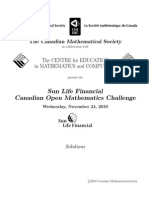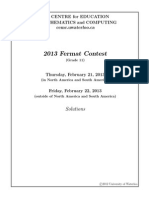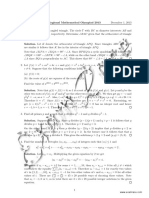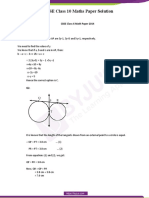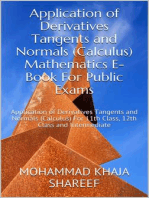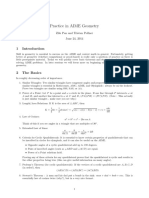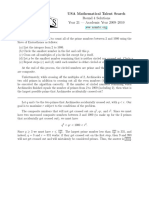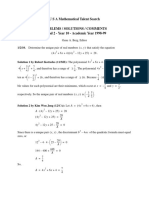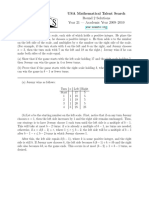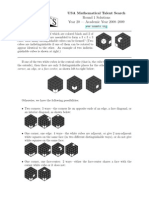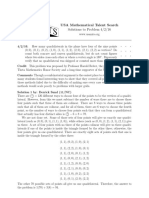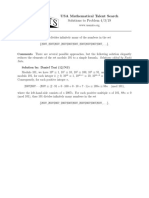Canadian Open Mathematics Challenge: The Canadian Mathematical Society
Uploaded by
สฮาบูดีน สาและCanadian Open Mathematics Challenge: The Canadian Mathematical Society
Uploaded by
สฮาบูดีน สาและThe Canadian Mathematical Society
in collaboration with
The CENTRE for EDUCATION
in MATHEMATICS and COMPUTING
The
Canadian Open
Mathematics Challenge
Wednesday, November 27, 2002
Solutions
2002 Canadian Mathematical Society
2002 COMC Solutions
Part A
1.
By Pythagoras in PFR , PF 2 = 132 5 2 = 144 , or
PF = 12 .
By Pythagoras in PFQ , PQ2 = 9 2 + 12 2 = 225 , or
PQ = 15 .
Therefore, the side lengths of PQR are 13, 14 and 15,
i.e. the perimeter is 42.
Q
2.
13
12
F 5 R
Solution 1
x 2 + 5 xy + y 2 = x 2 + 2 xy + y 2 + 3 xy
= ( x + y ) + 3 xy
2
= 4 2 + 3(12)
= 20
Solution 2
Examining the two given equations, we see that x = 6 and y = 2 is a solution.
Therefore, x 2 + 5 xy + y 2 = 6 2 + 5(6)(2) + (2) = 36 60 + 4 = 20 .
2
Solution 3
We solve the first equation for x and substitute into the second equation.
From the first equation, x = 4 y .
Substituting into the second equation, ( 4 y ) y = 12 or 0 = y 2 4 y 12 .
Factoring, 0 = ( y 6)( y + 2) , i.e. y = 6 or y = 2 . The corresponding values of x are
x = 2 and x = 6 , which give the same answer as in Solution 2, i.e. x 2 + 5 xy + y 2 = 20 .
3.
To determine EAR , we look at the angles around the
point E.
We know that AER + REN + NEP + PEA = 360o .
Since PEA is an angle in an equilateral triangle,
PEA = 60o .
Since NEP is an angle in a square, NEP = 90o .
Since REN is an angle in a regular pentagon, REN =
R
P
60 102
90 108
E
O
1
5
(540 ) = 108 .
o
2002 COMC Solutions
Therefore,
AER = 360o REN NEP PEA
= 360o 108o 90o 60o
= 102o
Now since PEA is an equilateral triangle, OPEN is a square, and TREND is a regular
pentagon, then their side lengths must all be the same, since OPEN and TREND share a
side, and since OPEN and PEA share a side. In particular, AE = ER .
Therefore, ARE is an isosceles triangle, and so
ARE = 12 180o AER = 12 180o 102o = 39o .
4.
) (
Solution 1
The sum of the 3rd, 4th and 5th terms of the sequence is equal to the sum of the first five
terms of the sequence minus the sum of the first two terms of the sequence.
][
Thus, the sum is 5(5) + 6(5) 5(2) + 6(2) = 155 32 = 123.
2
Solution 2
We determine the first 5 terms in the sequence and then add up the 3rd, 4th and 5th terms.
From the formula given, the sum of the first 1 terms is 11.
This tells us that the first term is 11.
From the formula given, the sum of the first 2 terms is 32. Since the first term is 11, then
the second term is 21.
Next, the sum of the first 3 terms is 63, and so the third term is 31, since the first two terms
are 11 and 21. (We could use the fact that the sum of the first two terms is 32, instead.)
Next, the sum of the first 4 terms is 104, and so the fourth term is 41.
Lastly, the sum of the first 5 terms is 155, and so the fifth term is 51.
Therefore, the sum of the 3rd, 4th and 5th terms is 31 + 41 + 51 = 123 .
Solution 3
Since the sum of the first n terms has a quadratic formula, then the terms in the sequence
have a common difference, i.e. The sequence is an arithmetic sequence.
Therefore, the sum of the 3rd, 4th and 5th terms is equal to three times the 4th term.
The 4th term is the sum of the first four terms minus the sum of the first three terms, i.e.
104 63 = 41.
Thus, the sum of the 3rd, 4th and 5th terms is 3( 41) = 123.
2002 COMC Solutions
5.
Solution 1
Since the value of this expression is the same for every positive integer a, then we can find
the value by substituting in a = 1.
Thus,
[(2a 1)(2a + 1)] = [13] = 1 + 2 + 3 = 6 = 2
[(a 1)(a + 1)] [02] 0 + 1 + 2 3
Therefore, the value required is 2.
Solution 2
If a is a positive integer, the only integer between 2 a 1 and 2 a + 1 is 2a . Similarly, the
only integer between a 1 and a + 1 is a.
Thus,
[(2a 1)(2a + 1)] = (2a 1) + 2a + (2a + 1) = 6a = 2
3a
(a 1) + a + (a + 1)
[(a 1)(a + 1)]
Therefore, the value required is 2.
6.
Label the two ends of the mirrors U and W, as shown.
Since the initial beam is parallel to the mirror WV, then UAS = 30o . Since the angle of
incidence equals the angle of reflection, then the reflected beam of light also makes an
angle of 30o with the mirror UV.
Let B be the point on the mirror WV that the light next strikes.
Since VAB = AVB = 30o , then the angle of incidence, ABW , is equal to 60o , because
it is an external angle of ABV . ( ABW could also have been calculated using the facts
that SAB = 120o and SA is parallel to WV.)
Therefore, the angle of reflection is also 60o .
U
Let C be the point on the mirror UV where the light next
o
o
A 1
30
strikes. Since CVB = 30 and VBC = 60 , then
S
2
1
BCV = 90o . This tells us that the light is reflected
30 C 1
2
straight back along its path from C back to S.
60 60 30
Therefore, the required distance is 2( SA + AB + BC ) .
W
V
B
Since we are given that SA = AV = 1, then since ABV is isosceles with BC an altitude,
then AC = CV = 12 , and so BC = 1 ( AC ) = 1 and AB = 2 ( AC ) = 1 .
3
Therefore, the required distance is
2( SA + AB + BC ) = 2 1 +
1
3
1
2 3
2 3
)=2+
3
3
=2+ 3
Thus, the total distance travelled by the beam is 2 + 3 m, or about 3.73 m.
2002 COMC Solutions
7.
Solution 1
Since P is formed by adding a 1 at the end of N, then P = 10 N + 1.
Since Q is formed by adding a 1 in front of the 5 digits of N, then Q = 100000 + N .
Since P = 3Q ,
10 N + 1 = 3(100000 + N )
10 N + 1 = 300000 + 3N
7 N = 299999
N = 42857
Therefore, N is 42857.
Solution 2
Suppose N has digits abcde. Then since P = 3Q , we have abcde1 = 3(1abcde) .
Since the units digit on the left side is 1, then the units digit on the right is also 1, which
means that e = 7 .
Thus, abcd 71 = 3(1abcd 7) . Since the tens digit on the left side is 7 and we get a carry of
2 from multiplying the last digit on the right side by 3, then 3 d has a units digit of 5, i.e.
d = 5.
Thus, abc 571 = 3(1abc 57) . Since the hundreds digit on the left side is 5 and we get a carry
of 1 from multiplying the last two digits on the right side by 3, then the units digit of 3 c
must be a 4, i.e. c = 8 .
Thus, ab8571 = 3(1ab857) . In a similar fashion, we see that b = 2 and a = 4 .
Therefore, N = 42857 .
8.
We are not told that M must be a positive integer, but it makes sense to look for a positive
integer M that satisfies these conditions, since we want the maximum possible value of M.
Since there are 1000 numbers in the set {1, 2, 3,K, 999,1000} and the probability that an x
1
chosen randomly from this set is a divisor of M is 100
, then M must have 10 divisors
between 1 and 1000.
Since we are told that M 1000 , then M must have exactly 10 positive divisors.
Therefore, M must be of the form p 9 where p is a prime number, or p 4 q where p and q are
both primes.
(Recall that to find the number of positive divisors of M, we find the prime factorization of
M and then take each of the exponents, add 1, and find the product of these numbers. For
example, if M = 48 = 2 4 3, then the number of positive divisors is ( 4 + 1)(1 + 1) = 10 .)
Now, we want to determine the maximum M in each of these two forms.
Case 1 M = p 9
Since M 1000 , then we must have p = 2 , i.e. M = 512 .
(If p = 3 , then p 9 = 19683 is too large.)
2002 COMC Solutions
Case 2 M = p 4 q
Since M 1000 and 5 4 = 625 , then we must have p = 2 or p = 3 .
If p = 2 , then the largest q can be so that q is prime and M 1000 is 61, i.e.
M = (16)(61) = 976 .
If p = 3 , then the largest q can be so that q is prime and M 1000 is 11, i.e.
M = (81)(11) = 891.
Therefore, the maximum possible value of M is 976.
Part B
1. (a)
The slope of the line through P and F is
5 1
1
=
08
2
and so the slope of the desired line is also 12 .
Since the point Q lies on the y-axis, then the y-intercept of the line is 3.
Therefore, the line is y = 12 x + 3 .
(b)
Since AD lies along the x-axis, then G is the
point where the line from (a) crosses the x-axis.
To find the coordinates of G, we set y = 0 in
the line from (a) to get 0 = 12 x + 3 or x = 6 .
Therefore, the desired line passes through the
points G(6, 0) and F (8,1) . Thus its slope is
1 0 1
= , and so its equation is
86 2
y 0 = 12 ( x 6) or y = 12 x 3.
(c)
Since FG has slope
1
.
2
1
,
2
y
C(8, 8)
B(0, 8)
P(0, 5)
Q(0, 3)
F(8, 1)
A(0, 0)
G(6, 0) D(8, 0)
then a line perpendicular to FG has slope 2 , the negative
reciprocal of
Since the desired line passes through H ( 4, 4 ) , it has equation y 4 = 2( x 4 ) or
y = 2 x + 12 .
2002 COMC Solutions
(d)
The circle has centre H ( 4, 4 ) , and it is tangent to
all four sides of the square, and so its radius must
be 4, since the distance from the centre to each of
the four sides is 4.
Does this circle intersect the line y = 12 x 3, i.e.
the line through F and G?
y
C(8, 8)
B(0, 8)
P(0, 5)
H(4, 4)
Q(0, 3)
F(8, 1)
A(0, 0)
G(6, 0) D(8, 0)
We must find the shortest distance between the centre of the circle and the line, i.e. the
perpendicular distance. We already have the equation of a line through H that is
perpendicular to the line through F and G, the line y = 2 x + 12 . Where do these lines
intersect? Setting y-coordinates equal,
1
x 3 = 2 x + 12
2
5
2
x = 15
x=6
i.e. the lines intersect at the point G(6, 0) ! Therefore, the shortest distance from H
to the line through F and G is the distance from H to G, which is
(6 4) 2 + (4 0) 2 = 20
i.e. is greater than than 4 = 16 , the radius of the circle.
Therefore, the circle does not intersect the line.
2.
(a)
For the product (2 A5)(13B) to be divisible by 36, we need it to be divisible by both 4
and 9. Since 2A5 is odd, it does not contain a factor of 2.
Therefore, 13B must be divisible by 4.
For a positive integer to be divisible by 4, the number formed by its last two digits must
be divisible by 4, i.e. 3B is divisible by 4, i.e. B = 2 or B = 6 .
Case 1 B = 2
In this case, 132 is divisible by 3, but not by 9. Therefore, for the original product to be
divisible by 9, we need 2A5 to be divisible by 3.
For a positive integer to be divisible by 3, the sum of its digits is divisible by 3, i.e.
2 + A + 5 = A + 7 is divisible by 3.
Therefore, A = 2 or 5 or 8 .
Case 2 B = 6
In this case, 136 contains no factors of 3, so for the original product to be divisible by 9,
we need 2A5 to be divisible by 9.
2002 COMC Solutions
For a positive integer to be divisible by 9, the sum of its digits is divisible by 9, i.e.
2 + A + 5 = A + 7 is divisible by 9. Therefore, A = 2 .
Therefore, the four possible ordered pairs are ( A, B) = (2, 2), (8, 2), (5, 2), (2, 6) .
(b)
(i)
If 10 a + b = 7 m , then b = 7 m 10 a . Thus,
a 2b = a 2( 7 m 10 a) = 21a 14 m = 7( 3a 2 m)
Since 3a 2 m is an integer, then by definition, a 2b is divisible by 7.
(ii)
Solution 1
If 5c + 4 d is divisible by 7, then 5c + 4 d = 7 k for some integer k.
Therefore, d = 41 ( 7 k 5c ) .
7( 3c k )
So 4 c d = 4 c 41 ( 7 k 5c ) = 41 (21c 7 k ) =
.
4
Since 4c d is an integer, then 7( 3c k ) must be divisible by 4. But 4 has no
3c k
common factors with 7, so 4 must divide into 3c k , i.e.
is an integer.
4
3c k
Therefore, 4 c d = 7
, i.e. 4c d is divisible by 7.
4
Solution 2
We note that 4 c d = (14 c + 7 d ) 2(5c + 4 d ) .
Since both terms on the right side are divisible by 7, then 4c d is divisible by 7.
Solution 3
Multiplying the expression 4c d by 5 does not affect its divisibility by 7.
Thus, we can consider whether or not 20c 5 d is divisible by 7, and this will be
equivalent to considering 4c d .
Since we are told that 5c + 4 d = 7 t for some integer t, then we know that
4 (5c + 4 d ) = 20c + 16 d = 28 t or 20c = 28 t 16 d .
If we now consider 20c 5 d , we see
20c 5 d = (28 t 16 d ) 5 d
= 28 t 21d
= 7( 4 t 3d )
Since 20c 5 d is divisible by 7 by definition, then 4c d is divisible by 7.
2002 COMC Solutions
3. (a)
(b)
We consider the possible cases. On his first turn, Alphonse can take either 1 marble or
2 marbles.
If Alphonse takes 1 marble, Beryl can take 2 marbles and then Colleen 1 marble, to
leave Alphonse with 1 marble left in the bowl. Therefore, Alphonse loses. (Note that
Beryl and Colleen can agree on their strategy before the game starts.)
If Alphonse takes 2 marbles, Beryl can take 1 marble and then Colleen 1 marble, to
leave Alphonse again with 1 marble left in the bowl. Therefore, Alphonse loses.
In either case, Beryl and Colleen can work together and force Alphonse to lose.
Solution 1
On their two consecutive turns, Beryl and Colleen remove in total 2, 3 or 4 marbles.
On his turn, Alphonse removes either 1 marble or 2 marbles. Therefore, by working
together, Beryl and Colleen can ensure that the total number of marbles removed on
any three consecutive turns beginning with Alphonses turn is 4 or 5. (Totals of 3 and 6
cannot be guaranteed because of Alphonses choice.)
Therefore, if N is a number of marbles in which Alphonse can be forced to lose, then so
are N + 4 and N + 5 , because Beryl and Colleen can force Alphonse to choose from N
marbles on his second turn.
From (a), we know that 5 is a losing position for Alphonse. Also, 1 is a losing position
for Alphonse. (Since 1 is a losing position, then 5 and 6 are both losing positions,
based on our earlier comment.)
Since 5 and 6 are losing positions, then we can determine that 9, 10 and 11 are also
losing positions, as are 13, 14, 15, and 16. If we add 4 to each of these repeatedly, we
see that N is a losing position for every N 13 .
What about the remaining possibilities, i.e. 2, 3, 4, 7, 8, and 12?
For N = 2 or N = 3, if Alphonse chooses 1 marble, then either Beryl or Colleen is
forced to take the last marble, so these are not losing positions for Alphonse, i.e. they
are winning positions.
For N = 4 , if Alphonse chooses 2 marbles, then either Beryl or Colleen is forced to
take the last marble, so this is also not a losing position for Alphonse.
Next, we notice that if Alphonse chooses 1 marble, then the total number of marbles
chosen by the three players will be 3, 4 or 5, and if Alphonse chooses 2 marbles, then
the total number chosen will be 4, 5 or 6.
So if N = 7 , then Alphonse can choose 1 marble and ensure that he receives 2, 3 or 4
marbles on his next turn. So 7 is a winning position for Alphonse.
2002 COMC Solutions
10
If N = 8 , then Alphonse can choose 2 marbles and ensure that he receives 2, 3 or 4
marbles on his next turn. So 8 is also a winning position for Alphonse.
Lastly, we consider N = 12 .
If Alphonse chooses 1 marble, Beryl and Colleen can choose 1 each and return 9
marbles to Alphonse. As we have shown, this is a losing position for Alphonse.
If Alphonse chooses 2 marbles, Beryl and Colleen can choose 2 each and return 6
marbles to Alphonse. This is a losing position for Alphonse.
Therefore, the values of N for which Beryl and Colleen can force Alphonse to lose are
1, 5, 6, and all N for which N 9 .
Solution 2
First, we notice that if Alphonse chooses 1 marble, then the total number of marbles
chosen by the three players will be 3, 4 or 5, and if Alphonse chooses 2 marbles, then
the total number chosen will be 4, 5 or 6.
We define a losing position to be a number of marbles in the bowl so that if Alphonse
starts with this number, he can be forced to lose.
From (a), we know that 5 is a losing position for Alphonse. Also, 1 is a losing position
for Alphonse.
For N = 2 or N = 3, if Alphonse chooses 1 marble, then either Beryl or Colleen is
forced to take the last marble, so these are not losing positions (ie. they are winning
positions) for Alphonse.
For N = 4 , if Alphonse chooses 2 marbles, then either Beryl or Colleen is forced to
take the last marble, so this is a winning position for Alphonse.
How can we ensure that a starting position N 6 is not a losing position?
N will not be a losing position if either none of N 3, N 4 or N 5 are losing
positions, or none of N 4 , N 5 or N 6 are losing positions. (If either group
consists of three non-losing positions, then Alphonse can ensure that he gets a position
from the appropriate set at the beginning of his next turn by choosing either 1 or 2
marbles respectively.)
Also, N will be a losing position as long as at least one of N 3, N 4 , N 5 and at
least one of N 4 , N 5 , N 6 are losing positions. (If there is a losing position in
each group of 3, then no matter whether Alphonse chooses 1 or 2 marbles, then Beryl
and Colleen will be able to force Alphonse into one of these previously known losing
positions.)
Using these two criteria for checking whether a position is a losing position or not a
losing position, we can see
2002 COMC Solutions
11
N = 6 is a losing position, since N 5 = 1 is a losing position in both groups of
three
N = 7 is not a losing position, since N 3, N 4 , N 5 (namely, 4, 3, 2) are not
ii)
losing positions.
iii) N = 8 is not a losing position, since N 4 , N 5 , N 6 (namely, 4, 3, 2) are not
losing positions.
iv) N = 9 is a losing position, since N 4 = 5 is a losing position in both groups of
three
N = 10 is a losing position, since N 5 = 5 is a losing position in both groups of
v)
three
vi) N = 11 is a losing position, since N 5 = 6 is a losing position in both groups of
three
vii) N = 12 is a losing position, since N 3 = 9 and N 6 = 6 are both losing
positions
i)
And so we have obtained 4 consecutive losing positions, which guarantees us that any
N 13 will also be a losing position, since N 4 will be a losing position in both
groups of 3.
Therefore, the values of N for which Beryl and Colleen can force Alphonse to lose are
1, 5, 6, and all N for which N 9 .
But among the first eight possibilities, there are now no more sets of three consecutive
non-losing positions. This tells us that every position for N 9 is a losing position,
since we cannot find three consecutive non-losing positions as described above.
Therefore, the values of N for which Beryl and Colleen can force Alphonse to lose are
1, 5, 6, and all N for which N 9 .
4.
Solution 1
Join E to P, Y and R, and join F to Q, Z and S.
Let O be the point of intersection of EY and FZ.
Since EY and FZ are altitudes in DEF , then the
third altitude, DX say, passes through O.
If we look at altitude DX, we see that DXE = 90o .
Since circle C2 has DE as its diameter, then point X
must lie on circle C2 , since a right angle is subtended
by the diameter at point X.
D
R
S
P
E
Similarly, point X lies on circle C1 .
Therefore, DX is a chord of both circle C1 and circle C2 .
We can now use the Chord-Chord Theorem in each of circle C1 and C2 , to say
2002 COMC Solutions
12
SO OQ = DO OX (from circle C2 )
RO OP = DO OX (from circle C1 )
From this we can conclude that SO OQ = RO OP .
Why does this allow us to conclude that P, Q, R, and S lie on the same circle?
SO RO
=
, which tells us that SOP is similar to ROQ ,
From the equation, we obtain
OP OQ
and so PSQ = PSO = ORQ = PRQ .
Since the chord PQ subtends the equal angles PSQ and PRQ (in an undrawn circle),
then the points P, Q, R, and S are concyclic.
Solution 2
In order to show that the four points lie on a circle, we will show that the points are
equidistant from a fifth point, which will thus be the centre of the circle on which the four
points lie.
Consider first the points Q and S. Any point equidistant from Q and S lies on the
perpendicular bisector of the line joining these points. Since Q and S both lie on circle C2 ,
DE is a diameter of C2 , and QS is perpendicular to DE (since they lie on an altitude of the
triangle), then DE is the perpendicular bisector of QS.
Similarly, DF is the perpendicular bisector of PR.
Therefore, any point that is equidistant from all four of the given points must lie on both
DE and DF. Thus, the only possible candidate is point D. (And we already know that
DS = DQ and DP = DR from our discussion of perpendicular bisectors.)
Thus, if we can show that DS = DR , then we will have shown what we need to show.
Method 1
Let SZ = c , DZ = a and EZ = b .
Then DS 2 = DZ 2 + SZ 2 = c 2 + a 2 (Pythagoras).
Now if we extract DSE , we see that DSE = 90o ,
since DE is a diameter of circle C2 . Therefore,
DZ SZ
DSZ is similar to SEZ , or
or c 2 = ab .
=
SZ EZ
Thus, DS 2 = a 2 + ab = a( a + b) = DZ DE .
D
R
a
S
c
b
P
E
Q
F
Similarly, DR 2 = DY DF , looking at DRF .
Now consider the points E, Z, Y, and F. Since EZF = EYF = 90o , then EF must be the
diameter of the circle containing points Y and Z (and points E and F).
Therefore, DE and DF are secants of the circle which intersect the circle at Z and Y,
respectively. By the Secant-Secant Theorem, DZ DE = DY DF .
2002 COMC Solutions
From above, we can conclude that DS 2 = DR 2 , or DS = DR , and thus
DP = DQ = DR = DS .
Method 2
As above, we can obtain that DS 2 = a 2 + ab = a( a + b) = DZ DE .
Since DZF = 90o , then DZ = DF cos(ZDF ) = DF cos(EDF ) , and so
DS 2 = DZ DE = DE DF cos(EDF ) .
Repeating the process on the other side of the triangle gives us that
DR 2 = DY DF = DF DE cos(EDF ) , or DR 2 = DS 2 .
Therefore, DP = DQ = DR = DS .
Therefore, we can conclude that the points P, Q, R, and S are concyclic.
13
You might also like
- Canadian Open Mathematics Challenge: The Canadian Mathematical SocietyNo ratings yetCanadian Open Mathematics Challenge: The Canadian Mathematical Society10 pages
- New Zealand Maths Olympiad Committee Friday Test, Solutions Camp 2006No ratings yetNew Zealand Maths Olympiad Committee Friday Test, Solutions Camp 20063 pages
- Srjmo 2022 Roundtwog 9 G 10 G 11 SolutionsNo ratings yetSrjmo 2022 Roundtwog 9 G 10 G 11 Solutions4 pages
- 2003 Solutions Cayley Contest: Canadian Mathematics CompetitionNo ratings yet2003 Solutions Cayley Contest: Canadian Mathematics Competition9 pages
- Asian Pacific Mathematics Olympiads-1989-2009No ratings yetAsian Pacific Mathematics Olympiads-1989-200979 pages
- Math Majors of America Tournament For High Schools: 2014 Individual Test SolutionsNo ratings yetMath Majors of America Tournament For High Schools: 2014 Individual Test Solutions4 pages
- Canadian Open Mathematics Challenge: The Canadian Mathematical SocietyNo ratings yetCanadian Open Mathematics Challenge: The Canadian Mathematical Society13 pages
- Geometry Solutions 2006 Rice Math Tournament February 25, 2006No ratings yetGeometry Solutions 2006 Rice Math Tournament February 25, 20063 pages
- UKMT - IMOK - Hamilton - Intermediate Mathematical Olympiad and Kangaroo 2012 - SolutionsNo ratings yetUKMT - IMOK - Hamilton - Intermediate Mathematical Olympiad and Kangaroo 2012 - Solutions7 pages
- USA Aime 1983: Problems & Solutions: X y Xyz ZNo ratings yetUSA Aime 1983: Problems & Solutions: X y Xyz Z6 pages
- GOA-Mathematics Sample Paper-1-SOLUTION-Class 10 Question Paper (SA-II)No ratings yetGOA-Mathematics Sample Paper-1-SOLUTION-Class 10 Question Paper (SA-II)15 pages
- 2002 Solutions Cayley Contest: Canadian Mathematics CompetitionNo ratings yet2002 Solutions Cayley Contest: Canadian Mathematics Competition9 pages
- International Mathematical Olympiad Preliminary Selection Contest 2012 - Hong KongNo ratings yetInternational Mathematical Olympiad Preliminary Selection Contest 2012 - Hong Kong7 pages
- Solutions To The 62nd William Lowell Putnam Mathematical Competition Saturday, December 1, 2001No ratings yetSolutions To The 62nd William Lowell Putnam Mathematical Competition Saturday, December 1, 20013 pages
- Geometry State Mathematics Finals Contest Solutions May 1, 2003No ratings yetGeometry State Mathematics Finals Contest Solutions May 1, 20039 pages
- CBSE Class 10 Maths Paper Solution 2011No ratings yetCBSE Class 10 Maths Paper Solution 201129 pages
- International Mathematical Olympiad Preliminary Selection Contest 2011 - Hong KongNo ratings yetInternational Mathematical Olympiad Preliminary Selection Contest 2011 - Hong Kong8 pages
- 2019 Junior Third Round - Solutions: 25 July 2019No ratings yet2019 Junior Third Round - Solutions: 25 July 20196 pages
- mathematics-cbse-grade-x-2019-series-jms-1-codeno-30-1-1No ratings yetmathematics-cbse-grade-x-2019-series-jms-1-codeno-30-1-117 pages
- Inmo-2012 Previous Year Question Papers of Indian National Mathematical Olympiad (INMO) With SolutionsNo ratings yetInmo-2012 Previous Year Question Papers of Indian National Mathematical Olympiad (INMO) With Solutions6 pages
- Application of Derivatives Tangents and Normals (Calculus) Mathematics E-Book For Public ExamsFrom EverandApplication of Derivatives Tangents and Normals (Calculus) Mathematics E-Book For Public Exams5/5 (1)
- 10+2 Level Mathematics For All Exams GMAT, GRE, CAT, SAT, ACT, IIT JEE, WBJEE, ISI, CMI, RMO, INMO, KVPY Etc.From Everand10+2 Level Mathematics For All Exams GMAT, GRE, CAT, SAT, ACT, IIT JEE, WBJEE, ISI, CMI, RMO, INMO, KVPY Etc.No ratings yet
- USA Mathematical Talent Search Round 1 Solutions Year 22 - Academic Year 2010-2011No ratings yetUSA Mathematical Talent Search Round 1 Solutions Year 22 - Academic Year 2010-201115 pages
- U S A Mathematical Talent Search: November 14, 1998No ratings yetU S A Mathematical Talent Search: November 14, 19981 page
- USA Mathematical Talent Search Solutions To Problem 5/4/19: P P P PNo ratings yetUSA Mathematical Talent Search Solutions To Problem 5/4/19: P P P P2 pages
- USA Mathematical Talent Search Round 4 Solutions Year 21 - Academic Year 2009-2010No ratings yetUSA Mathematical Talent Search Round 4 Solutions Year 21 - Academic Year 2009-20107 pages
- U S A Mathematical Talent Search: 1/2/10. Determine The Unique Pair of Real NumbersNo ratings yetU S A Mathematical Talent Search: 1/2/10. Determine The Unique Pair of Real Numbers10 pages
- USA Mathematical Talent Search Solutions To Problem 5/3/17No ratings yetUSA Mathematical Talent Search Solutions To Problem 5/3/175 pages
- U S A Mathematical Talent Search: Later Than September 12, 1998No ratings yetU S A Mathematical Talent Search: Later Than September 12, 19981 page
- USA Mathematical Talent Search Solutions To Problem 4/4/18: Valid Valid Invalid: Loop Invalid: Not ConnectedNo ratings yetUSA Mathematical Talent Search Solutions To Problem 4/4/18: Valid Valid Invalid: Loop Invalid: Not Connected2 pages
- USA Mathematical Talent Search Round 2 Solutions Year 21 - Academic Year 2009-2010No ratings yetUSA Mathematical Talent Search Round 2 Solutions Year 21 - Academic Year 2009-20106 pages
- USA Mathematical Talent Search Solutions To Problem 4/3/16: XX X X XX X XNo ratings yetUSA Mathematical Talent Search Solutions To Problem 4/3/16: XX X X XX X X4 pages
- USA Mathematical Talent Search Solutions To Problem 5/4/18No ratings yetUSA Mathematical Talent Search Solutions To Problem 5/4/183 pages
- USA Mathematical Talent Search Solutions To Problem 5/1/19No ratings yetUSA Mathematical Talent Search Solutions To Problem 5/1/191 page
- USA Mathematical Talent Search Solutions To Problem 5/3/18No ratings yetUSA Mathematical Talent Search Solutions To Problem 5/3/182 pages
- USA Mathematical Talent Search Solutions To Problem 5/3/19No ratings yetUSA Mathematical Talent Search Solutions To Problem 5/3/193 pages
- USA Mathematical Talent Search Round 4 Solutions Year 20 - Academic Year 2008-2009No ratings yetUSA Mathematical Talent Search Round 4 Solutions Year 20 - Academic Year 2008-20097 pages
- USA Mathematical Talent Search Solutions To Problem 5/2/18: D A F ENo ratings yetUSA Mathematical Talent Search Solutions To Problem 5/2/18: D A F E1 page
- USA Mathematical Talent Search Solutions To Problem 5/1/18No ratings yetUSA Mathematical Talent Search Solutions To Problem 5/1/182 pages
- USA Mathematical Talent Search Solutions To Problem 5/1/17No ratings yetUSA Mathematical Talent Search Solutions To Problem 5/1/176 pages
- USA Mathematical Talent Search Solutions To Problem 4/4/19No ratings yetUSA Mathematical Talent Search Solutions To Problem 4/4/192 pages
- USA Mathematical Talent Search Solutions To Problem 4/2/16: Q Q Q Q Q QNo ratings yetUSA Mathematical Talent Search Solutions To Problem 4/2/16: Q Q Q Q Q Q4 pages
- USA Mathematical Talent Search Solutions To Problem 4/4/17No ratings yetUSA Mathematical Talent Search Solutions To Problem 4/4/171 page
- B B at @ B B B B: USA Mathematical Talent Search Solutions To Problem 5/1/16No ratings yetB B at @ B B B B: USA Mathematical Talent Search Solutions To Problem 5/1/166 pages
- USA Mathematical Talent Search Solutions To Problem 4/4/16No ratings yetUSA Mathematical Talent Search Solutions To Problem 4/4/166 pages
- USA Mathematical Talent Search Solutions To Problem 4/3/19: 0 1 2 3 4 4k 4k+1 4k+2 4k+3No ratings yetUSA Mathematical Talent Search Solutions To Problem 4/3/19: 0 1 2 3 4 4k 4k+1 4k+2 4k+31 page
- The2010acmicpcworldfinalswarmup2 100123224100 Phpapp01No ratings yetThe2010acmicpcworldfinalswarmup2 100123224100 Phpapp0113 pages
- (Ebook) The Millennium Problems: The Seven Greatest Unsolved Mathematical Puzzles of our Time by Keith Devlin ISBN 9780465017294, 0465017290download100% (3)(Ebook) The Millennium Problems: The Seven Greatest Unsolved Mathematical Puzzles of our Time by Keith Devlin ISBN 9780465017294, 0465017290download50 pages
- Differential Calculus: Limits and Continuity, Derivatives, IntegrationNo ratings yetDifferential Calculus: Limits and Continuity, Derivatives, Integration40 pages
- Discrete Mathematics With Algorithms (Albertson & Hutchinson 1988-07-22)No ratings yetDiscrete Mathematics With Algorithms (Albertson & Hutchinson 1988-07-22)550 pages
- Chapter 4. Number Theory and CryptographyNo ratings yetChapter 4. Number Theory and Cryptography149 pages
- Exercise Paper Set 1 North Vista SA2 2021No ratings yetExercise Paper Set 1 North Vista SA2 202117 pages
- வைத்திய சாஸ்திரம், மாந்திரீகம், சிவ அர்ச்சனைNo ratings yetவைத்திய சாஸ்திரம், மாந்திரீகம், சிவ அர்ச்சனை11 pages
- Year 5 and 6 Spring Block 3 Number AlgebraNo ratings yetYear 5 and 6 Spring Block 3 Number Algebra44 pages
- Solved RRB JE 1st June 2019 Shift-3 Paper With SolutionsNo ratings yetSolved RRB JE 1st June 2019 Shift-3 Paper With Solutions39 pages
- Canadian Open Mathematics Challenge: The Canadian Mathematical SocietyCanadian Open Mathematics Challenge: The Canadian Mathematical Society
- New Zealand Maths Olympiad Committee Friday Test, Solutions Camp 2006New Zealand Maths Olympiad Committee Friday Test, Solutions Camp 2006
- 2003 Solutions Cayley Contest: Canadian Mathematics Competition2003 Solutions Cayley Contest: Canadian Mathematics Competition
- Math Majors of America Tournament For High Schools: 2014 Individual Test SolutionsMath Majors of America Tournament For High Schools: 2014 Individual Test Solutions
- Canadian Open Mathematics Challenge: The Canadian Mathematical SocietyCanadian Open Mathematics Challenge: The Canadian Mathematical Society
- Geometry Solutions 2006 Rice Math Tournament February 25, 2006Geometry Solutions 2006 Rice Math Tournament February 25, 2006
- UKMT - IMOK - Hamilton - Intermediate Mathematical Olympiad and Kangaroo 2012 - SolutionsUKMT - IMOK - Hamilton - Intermediate Mathematical Olympiad and Kangaroo 2012 - Solutions
- GOA-Mathematics Sample Paper-1-SOLUTION-Class 10 Question Paper (SA-II)GOA-Mathematics Sample Paper-1-SOLUTION-Class 10 Question Paper (SA-II)
- 2002 Solutions Cayley Contest: Canadian Mathematics Competition2002 Solutions Cayley Contest: Canadian Mathematics Competition
- International Mathematical Olympiad Preliminary Selection Contest 2012 - Hong KongInternational Mathematical Olympiad Preliminary Selection Contest 2012 - Hong Kong
- Solutions To The 62nd William Lowell Putnam Mathematical Competition Saturday, December 1, 2001Solutions To The 62nd William Lowell Putnam Mathematical Competition Saturday, December 1, 2001
- Geometry State Mathematics Finals Contest Solutions May 1, 2003Geometry State Mathematics Finals Contest Solutions May 1, 2003
- International Mathematical Olympiad Preliminary Selection Contest 2011 - Hong KongInternational Mathematical Olympiad Preliminary Selection Contest 2011 - Hong Kong
- mathematics-cbse-grade-x-2019-series-jms-1-codeno-30-1-1mathematics-cbse-grade-x-2019-series-jms-1-codeno-30-1-1
- Inmo-2012 Previous Year Question Papers of Indian National Mathematical Olympiad (INMO) With SolutionsInmo-2012 Previous Year Question Papers of Indian National Mathematical Olympiad (INMO) With Solutions
- Transformation of Axes (Geometry) Mathematics Question BankFrom EverandTransformation of Axes (Geometry) Mathematics Question Bank
- Application of Derivatives Tangents and Normals (Calculus) Mathematics E-Book For Public ExamsFrom EverandApplication of Derivatives Tangents and Normals (Calculus) Mathematics E-Book For Public Exams
- 10+2 Level Mathematics For All Exams GMAT, GRE, CAT, SAT, ACT, IIT JEE, WBJEE, ISI, CMI, RMO, INMO, KVPY Etc.From Everand10+2 Level Mathematics For All Exams GMAT, GRE, CAT, SAT, ACT, IIT JEE, WBJEE, ISI, CMI, RMO, INMO, KVPY Etc.
- USA Mathematical Talent Search Round 1 Solutions Year 22 - Academic Year 2010-2011USA Mathematical Talent Search Round 1 Solutions Year 22 - Academic Year 2010-2011
- U S A Mathematical Talent Search: November 14, 1998U S A Mathematical Talent Search: November 14, 1998
- USA Mathematical Talent Search Solutions To Problem 5/4/19: P P P PUSA Mathematical Talent Search Solutions To Problem 5/4/19: P P P P
- USA Mathematical Talent Search Round 4 Solutions Year 21 - Academic Year 2009-2010USA Mathematical Talent Search Round 4 Solutions Year 21 - Academic Year 2009-2010
- U S A Mathematical Talent Search: 1/2/10. Determine The Unique Pair of Real NumbersU S A Mathematical Talent Search: 1/2/10. Determine The Unique Pair of Real Numbers
- USA Mathematical Talent Search Solutions To Problem 5/3/17USA Mathematical Talent Search Solutions To Problem 5/3/17
- U S A Mathematical Talent Search: Later Than September 12, 1998U S A Mathematical Talent Search: Later Than September 12, 1998
- USA Mathematical Talent Search Solutions To Problem 4/4/18: Valid Valid Invalid: Loop Invalid: Not ConnectedUSA Mathematical Talent Search Solutions To Problem 4/4/18: Valid Valid Invalid: Loop Invalid: Not Connected
- USA Mathematical Talent Search Round 2 Solutions Year 21 - Academic Year 2009-2010USA Mathematical Talent Search Round 2 Solutions Year 21 - Academic Year 2009-2010
- USA Mathematical Talent Search Solutions To Problem 4/3/16: XX X X XX X XUSA Mathematical Talent Search Solutions To Problem 4/3/16: XX X X XX X X
- USA Mathematical Talent Search Solutions To Problem 5/4/18USA Mathematical Talent Search Solutions To Problem 5/4/18
- USA Mathematical Talent Search Solutions To Problem 5/1/19USA Mathematical Talent Search Solutions To Problem 5/1/19
- USA Mathematical Talent Search Solutions To Problem 5/3/18USA Mathematical Talent Search Solutions To Problem 5/3/18
- USA Mathematical Talent Search Solutions To Problem 5/3/19USA Mathematical Talent Search Solutions To Problem 5/3/19
- USA Mathematical Talent Search Round 4 Solutions Year 20 - Academic Year 2008-2009USA Mathematical Talent Search Round 4 Solutions Year 20 - Academic Year 2008-2009
- USA Mathematical Talent Search Solutions To Problem 5/2/18: D A F EUSA Mathematical Talent Search Solutions To Problem 5/2/18: D A F E
- USA Mathematical Talent Search Solutions To Problem 5/1/18USA Mathematical Talent Search Solutions To Problem 5/1/18
- USA Mathematical Talent Search Solutions To Problem 5/1/17USA Mathematical Talent Search Solutions To Problem 5/1/17
- USA Mathematical Talent Search Solutions To Problem 4/4/19USA Mathematical Talent Search Solutions To Problem 4/4/19
- USA Mathematical Talent Search Solutions To Problem 4/2/16: Q Q Q Q Q QUSA Mathematical Talent Search Solutions To Problem 4/2/16: Q Q Q Q Q Q
- USA Mathematical Talent Search Solutions To Problem 4/4/17USA Mathematical Talent Search Solutions To Problem 4/4/17
- B B at @ B B B B: USA Mathematical Talent Search Solutions To Problem 5/1/16B B at @ B B B B: USA Mathematical Talent Search Solutions To Problem 5/1/16
- USA Mathematical Talent Search Solutions To Problem 4/4/16USA Mathematical Talent Search Solutions To Problem 4/4/16
- USA Mathematical Talent Search Solutions To Problem 4/3/19: 0 1 2 3 4 4k 4k+1 4k+2 4k+3USA Mathematical Talent Search Solutions To Problem 4/3/19: 0 1 2 3 4 4k 4k+1 4k+2 4k+3
- The2010acmicpcworldfinalswarmup2 100123224100 Phpapp01The2010acmicpcworldfinalswarmup2 100123224100 Phpapp01
- (Ebook) The Millennium Problems: The Seven Greatest Unsolved Mathematical Puzzles of our Time by Keith Devlin ISBN 9780465017294, 0465017290download(Ebook) The Millennium Problems: The Seven Greatest Unsolved Mathematical Puzzles of our Time by Keith Devlin ISBN 9780465017294, 0465017290download
- Differential Calculus: Limits and Continuity, Derivatives, IntegrationDifferential Calculus: Limits and Continuity, Derivatives, Integration
- Discrete Mathematics With Algorithms (Albertson & Hutchinson 1988-07-22)Discrete Mathematics With Algorithms (Albertson & Hutchinson 1988-07-22)
- Solved RRB JE 1st June 2019 Shift-3 Paper With SolutionsSolved RRB JE 1st June 2019 Shift-3 Paper With Solutions

